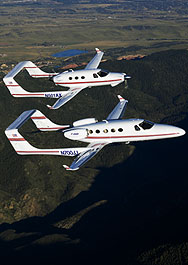Light on the pocket, high on convenience
20 Jan 2007
 Available for a mere $1.6 million (Rs7.11 crore), the innovative Eclipse 500 has not only succeeded in creating an aviation sub-class, but also in attracting Wal-Mart's attention, a entity whose business strategy focuses rigorously on addressing volumes for any product. 2007 may or may not turn out to be the year of the VLJ, but a heavy weight like Wal-Mart would certainly appear to be backing that hunch.
Available for a mere $1.6 million (Rs7.11 crore), the innovative Eclipse 500 has not only succeeded in creating an aviation sub-class, but also in attracting Wal-Mart's attention, a entity whose business strategy focuses rigorously on addressing volumes for any product. 2007 may or may not turn out to be the year of the VLJ, but a heavy weight like Wal-Mart would certainly appear to be backing that hunch.
Far cheaper to maintain
Under 10,000-pounds in weight, a very light jet is generally a single-pilot, 4-6 passenger airplane with a 41,000-ft operating ceiling. The smallest versions can operate from 3,000-ft runways. Generally these aircraft will cruise above the clouds at approx. 425 miles per hour (on an average) and use smaller airports, thereby facilitating point – to point arrivals and departures, and also saving travellers of dealing with the hassles associated with large city airline hubs.
Lighter and smaller, with fuel efficient engines, VLJs dispense with the need for flight crews to operate them. Advances in composite materials and aircraft construction, and the development of sophisticated avionics are primarily responsible for the emergence of the small sized, single-pilot VLJs. All these factors also combine to make the VLJ a far cheaper aircraft to maintain than the heavier and costlier 'business jets'.
Following Eclipse Aviation's innovative lead, other manufacturers have rushed in to expand the VLJ space with their different designs and products. The twin-boomed A700 from Adam Aircraft, the D-Jet from Diamond Aircraft, the EpicJet from Epic Aircraft, Embraer's Phenom 100, Honda's HondaJet, Cessna's Mustang and ATG's Javelin are some of the others now vying for attention. Innovative designs, still on the drawing boards, are already inviting buy orders.
Seeking the niche
Eclipse Aviation, which received certification for its Eclipse 500 from the US Federal Aviation Authority in August 2006, has already attracted buy orders running into thousands. More than any other VLJ, the Eclipse 500 is expected to spearhead the rapidly forming air-taxi market in the US, Europe and elsewhere.
While air franchise/taxi operations have been around for quite some time, thanks the emergence of the VLJ will enable this segment of the air travel market to show its true potential. The affordability, and ease of operation, that the VLJ allows is already leading to the development of innovative concepts in air travel, such as point-to-point air taxis. VLJ makers are counting on growth of the air taxi market. And they are not being unrealistic.
DayJet, a Florida-based air-taxi company that intends to start up early next year, has placed 239 firm orders for the Eclipse jets. DayJet's strategy hinges around attracting business travellers who normally drive towards short-haul jet travel. This it intends to do by providing on-demand travel between smaller airports. The ticket cost will be equivalent to a standard airline ticket, plus the cost of an overnight stay, which the short-haul now renders unnecessary.
For DayJet the target is the middle tier of business travellers, who currently do not have any options, other than to do the long-haul, by road or rail. The idea is to create a whole new class of users, a new 'group of users,' rather than one for every person on the planet. As Eclipse's Raburn puts it, not quite 'VolksJet' as yet.
Away from home
Though currently focussed on the US and European markets, VLJ makers know that true growth lies elsewhere. Eclipse Aviation executives say that the company will launch a worldwide marketing effort in 2007.
They concede that 70-80 per cent of their sales are derived from the US market, but they expect their order books to reflect a more balanced 50-50 distribution between the domestic market and the rest of the world in the coming 3-4 years.
According to Eclipse CEO, Vern Raburn, the VLJ could perform the same role as wireless technology in the communications sector. By leapfrogging expensive optic cable systems, wireless technology allowed developing nations to rapidly advance their communications infrastructure. Low – cost, but state-of-the-art technology, which the VLJ brings into play, could allow nations to sidestep a lot of expenses in developing expensive aviation infrastructure. The VLJs capability to operate from tiny airfields across the country holds the potential to bring in commercial air services where none existed, and that too at a fraction of the cost.
Destination India
Raburn concedes that so far Eclipse has not invested any effort or money into developing such markets, but intends doing so from 2007. He is sanguine about not striking early successes, and comfortable about an 18-month gestation period. In any case, being fully booked, Eclipse doesn't have any aircraft to deliver in this time span.
Sometime in August 2006, however, Eclipse did announce that it would be sending a team to India to scout the country's market potential. Raburn had mentioned earlier that he had "particularly high hopes on India". The visit would test out these hopes, and also, the company's larger strategy, to eventually balance their sales half and half between their domestic and foreign markets.
According to Eclipse executives, the country's booming economy, a large number of educated and prosperous people who would prefer affordable private jet travel, its large and already existing aviation infrastructure and a growing roster of wealthy individuals and companies made India a compelling market.













.jpg)






.jpg)









